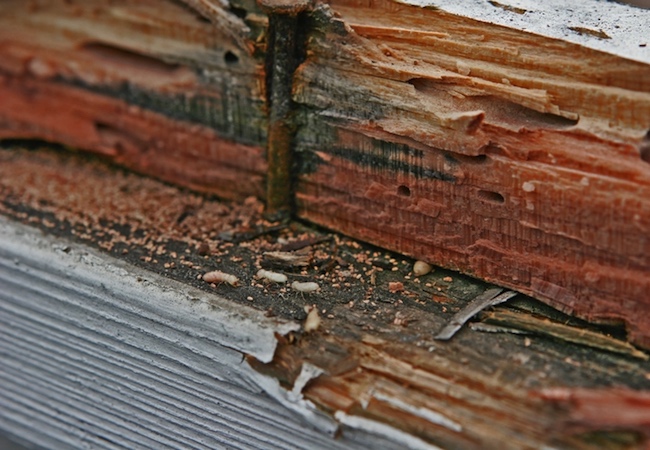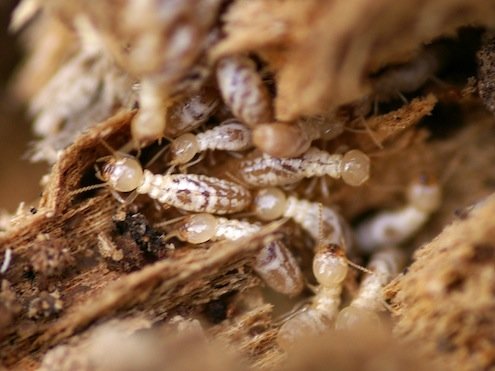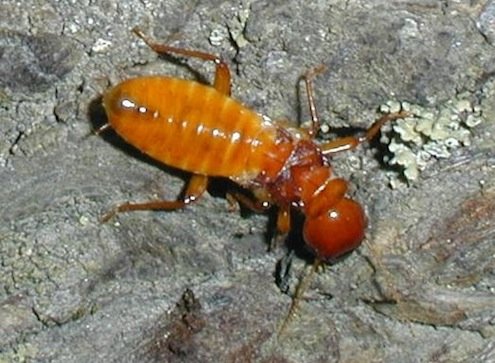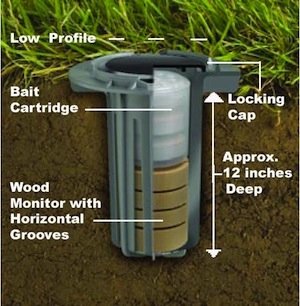

We may earn revenue from the products available on this page and participate in affiliate programs. Learn More ›
Q: I live in an older home, and I recently noticed flying insects and piles of wings near the foundation. I’m worried I might have a termite infestation; how can I tell, and if I do have termites, what do I need to do to get rid of them?
A: Seeing any type of insect in your home can be unnerving, but if you suspect you have termites, that feeling can quickly turn to panic. After all, termites are known for causing major damage to a home’s structure, so it’s natural to worry about termite treatment costs if you suspect an infestation. Luckily, if you catch it early enough, a termite infestation doesn’t have to spell disaster.

“Homeowners [will want] to take the necessary steps to protect their greatest investment from costly damage,” says Scott Fortson, president of Terminix Service, Inc., a South Carolina–based franchise of pest management firm Terminix International. “Because termites aren’t often detected until it’s too late, we advise consumers to arrange for termite protection from a qualified pest professional.” A professional exterminator knows how to get rid of termites the best way and how to prevent future infestations.
Learn more about the most common signs of termites, different types of termites and what termites look like, the most effective treatment methods, and the ways you can prevent future termite infestations in your home.

Some of the biggest signs of a termite infestation include swarming termites, mud tubes, termites droppings, moldy smells, and damage to wood and paint.
The National Pest Management Association (NPMA) reports that termites cause more than $5 billion in property damage each year. Luckily, there are several signs of termites that homeowners can watch out for when they’re wondering if the bugs they’re seeing are termites or just bugs that look like termites. If it’s termites, it’s important to note that termite damage generally isn’t covered by homeowners insurance. For this reason, homeowners who notice any of the following nine termite infestation signs will want to get an inspection to determine whether or not they have an infestation in their home.
- Swarming termites or discarded wings. Termites with wings can be active during the spring and fall when they leave the colony to find a mate. At this time, homeowners may notice swarms of flying termites or even piles of discarded wings. A pro can identify whether the swarms or wings belong to termites or ants.
- Mud tubes. Certain termites live underground and make tunnels, or mud tubes, to get to food or shelter. According to the Mississippi State University Extension, mud tubes most commonly appear near the home’s foundation but can also be found higher up on a building or on soffit and fascia boards. Homeowners who notice mud tubes can remove the top layer of dirt and look for live insects to determine if they have an infestation.
- Termite droppings. Also called frass, termite droppings resemble sawdust or coffee grounds and tend to pile up in mounds on floors and windowsills. Frass is composed of fecal matter, wood shavings, and dirt.
- Moldy smells. Some termites prefer wood with a high moisture content, which can give off a moldy or musty scent. Although this type of smell isn’t always an indication of a termite infestation, homeowners who notice this smell alongside other termite signs will want to get an inspection immediately.
- Buckling or blistering wood floors or loose floor tiles. Termites can damage a home’s subfloor as they tunnel, which can cause buckling or blistering wood floors or loose tiles. Wood floors may appear discolored or take on a wavy appearance, while tile floors can loosen and become a tripping hazard.
- Damaged wood. Termites feed on the cellulose in wood, so one of the most common signs of an infestation is wood damage. As termites eat through wood, they cause it to become hollow and structurally unsound. Homeowners can identify hollow wood by tapping on it; if there’s a termite infestation, the wood will sound empty inside. Homeowners wondering if they have termite damage or wood rot can contact a professional to identify the issue.
- Damage drywall or bubbling paint. Although drywall isn’t made from wood, it contains cellulose, which is the main food source for termites. Homeowners may notice trails along drywall that appear as the termites eat through it, and there may be small holes in the wallpaper where the termites entered the wall. Termites can also cause bubbling under paint or wallpaper.
- Stuck doors or windows. As termites eat through the wooden structure of a home, they cause the wood to buckle or warp, which creates structural problems. A noticeable sign of this is windows and doors that are stuck or hard to open. Homeowners who notice this will want to schedule a termite inspection.
- Dipping or cracking ceilings. Structural damage caused by a termite infestation can also cause ceilings to dip and crack. Once this starts to happen, there’s likely serious structural damage, so homeowners will want to take immediate action.
Unfortunately, it’s possible for termites to be present inside a home for a while before detection, which increases the potential for extensive termite damage repair costs. That’s why it’s so important for homeowners to take these signs seriously and choose a termite company to perform an inspection if they suspect a termite infestation.

There are several types of termites in the U.S., with subterranean termites causing the most structural damage to homes.
The U.S. is home to several species of termites. Although all termites are capable of causing damage, subterranean termites cause by far the most damage to American homes. Subterranean termites live underground or in moist, secluded areas above ground, and colonies can be as big as 2 million. Each subterranean termite measures up to 1 inch in length and is cream colored. This type of termite lives in the ground and gets into homes by creating mud tubes through foundation cracks and expansion joints, along plumbing and electrical penetrations, behind veneer, and anywhere wood meets the ground. Subterranean house termites are present in every state except Alaska, with Formosan termites causing by far the most damage.
Dampwood termites infest wood with high moisture content. It’s uncommon to find dampwood termites in a home since the wood is usually not damp enough to attract them. Dampwood termites can be found in the Southwest, Idaho, Montana, California, Oregon, Washington, and southern Florida.
Drywood termites infest dry wood, such as dead trees, hardwood floors, and structural timber. Although drywood termites in a house can cause significant damage, their colonies tend to be much smaller than subterranean termite colonies, which limits the scope of damage. Drywood termites do not use soil to access their food source, so mud tubes won’t be present with this type of infestation. Drywood termites are present in the Southwestern and Southeastern United States. Conehead termites are a type of drywood termite that’s native to Florida and the Caribbean.
Once you’ve identified a termite infestation, it’s vital to contact a professional as soon as possible.

As soon as a homeowner notices the telltale signs of a termite infestation, they’ll want to get professional help immediately. The best termite control companies (like Terminix or Ehrlich Pest Control) will first perform a termite inspection to determine the extent of the infestation. Following the inspection, the exterminator will recommend the best termite treatment based on the severity of the problem. The three major methods of elimination are termite baits, liquid termite infestation treatments, and barrier treatments.
- Termite baits are placed around the home and gradually eliminate the population as workers carry the pesticides back to the colony. Liquid treatments are sprayed around the home to kill and repel any termites coming into contact with the chemicals.
- Liquid borate is another treatment option. Typically used in new construction, borate is applied directly to the wood of the house as a coating.
- Barrier treatments are applied to the soil and contain termiticides designed to wipe out a termite colony. However, the U.S. Environmental Protection Agency (EPA) reports that termiticide can contaminate drinking water to a home and surrounding area, which is why it’s essential for homeowners to leave the work to a pro.
Termite inspection costs around $133, but the inspection fee may be waived if the homeowner hires the pest control company to perform termite treatment. Some treatment options work on specific species in specific geographic areas. For instance, fumigation, electrocution, and liquid nitrogen are often effective in controlling drywood termites, which are common house termites in southern states. Heating and microwave treatments are used elsewhere.
Because termite damage can go undetected, the NPMA and Terminix also recommend an annual termite inspection by a licensed professional.
There are several steps you can take to prevent future termite infestations.
One of the best ways to fight off termites is to prevent the infestation in the first place. By taking some simple preventive measures, homeowners can decrease the chances of their home becoming infested by termites.
- Keep an eye out for signs of termites. Homeowners will want to frequently inspect the perimeter of their home for common signs of termites, such as mud tubes, frass, and rotting wood.
- Direct water away from the home. Gutters and downspouts play an important part in keeping a home structurally sound. Clogged gutters and downspouts can result in water pooling by the home’s foundation, which can attract dampwood termites. Homeowners can also work on actively diverting water away from their home’s foundation.
- Keep up with repairs. Broken fascia, soffits, and roof shingles can lead to rot and pest infestations. Many common home repairs cost less if the homeowner addresses them early on. Waiting to repair these issues can result in additional damage, which costs more to repair than minor damage.
- Ensure proper ventilation. Homeowners will want to keep their home’s basement, attic, and crawl space well ventilated and dry to prevent termite infestations.
- Store wood away from the home. Any wood in direct contact with the soil and the home’s structure is vulnerable to termites. Homeowners will want to store firewood at least 20 feet away from the house and check it for pests before bringing it indoors.
These preventive tips may seem simple, but they can help homeowners either prevent termite infestations altogether or catch them early before they have time to cause serious structural damage to the home. Once a termite infestation has been identified, the homeowner can contact a pro who knows how to kill termites and keep them from coming back.
